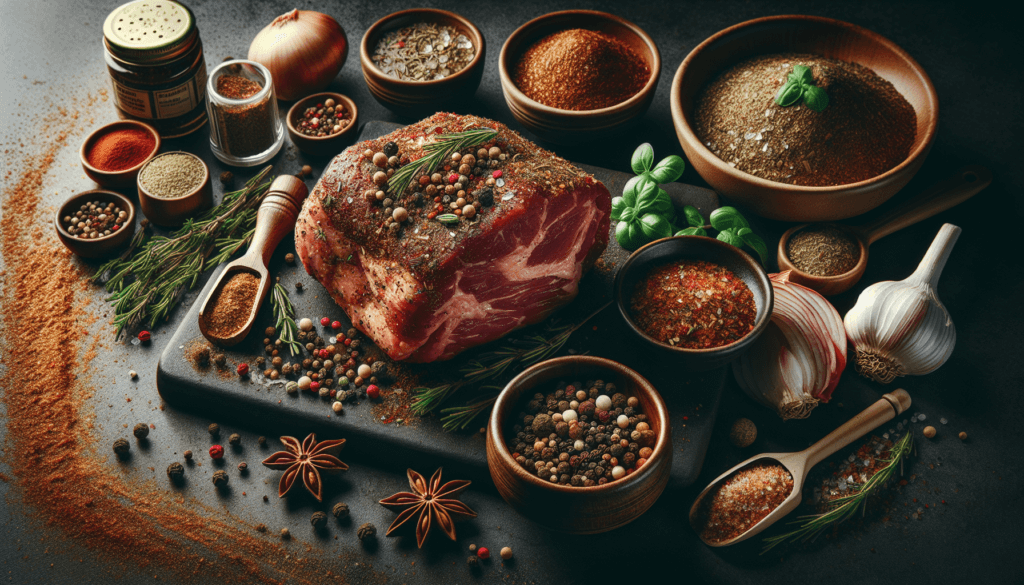If you’ve always wanted to take your cooking skills up a notch and impress your guests with tender, flavorful meats, then look no further. In this article, you will discover the secret to perfectly brining and seasoning meats. Learn the step-by-step process on how to enhance the juiciness and taste of your favorite cuts, making them irresistibly delicious. Whether you’re a seasoned chef or a beginner in the kitchen, this guide will equip you with the knowledge and techniques needed to elevate your culinary creations to new heights. Get ready to savor a mouthwatering experience with every bite!

Choosing the Right Meat
Selecting the Meat Cuts
When it comes to cooking meat, the first step in achieving a delicious dish is choosing the right cut. Different cuts of meat have varying levels of tenderness, flavor, and fat content, so it’s important to consider these factors when making your selection. Whether you’re opting for beef, pork, chicken, or any other type of meat, take the time to familiarize yourself with the different cuts and their qualities. This will help you determine the best cut for your recipe and ensure that the meat cooks evenly and to perfection.
Considering the Thickness of the Meat
When choosing meat for your meal, it’s essential to consider the thickness of the cuts. Thicker pieces of meat require different cooking methods and times compared to thinner ones. Thicker cuts generally take longer to cook and may require lower temperatures to ensure that the inside is cooked to the desired doneness without overcooking the outside. On the other hand, thinner cuts might require higher heat to sear the surface and cook quickly. By taking the thickness of the meat into account, you can adjust your cooking method accordingly and achieve evenly cooked and flavorful results.
Understanding Brining
What is Brining?
Brining is a process that involves soaking meat in a mixture of water, salt, and sometimes sugar and other flavorings. The purpose of brining is to improve the moisture and flavor retention of the meat while tenderizing it. The salt in the brine solution works by helping the meat retain more moisture during the cooking process, resulting in juicier and more tender meat. Brining is particularly beneficial for leaner cuts of meat, such as chicken breast or pork loin, which tend to dry out easily during cooking.
The Benefits of Brining
Brining offers several benefits that can elevate the quality of your meat dishes. Firstly, the salt in the brine solution enhances the natural flavors of the meat, making each bite more enjoyable. Secondly, by entering the meat through osmosis, the salt in the brine solution improves the meat’s ability to retain moisture, resulting in juicier meat. Lastly, brining also helps to tenderize tougher cuts of meat, making them more tender and flavorful.
Different Brining Methods
There are two primary methods of brining: wet brining and dry brining. Wet brining involves submerging the meat in a brine solution for a specified period, allowing the meat to soak up the flavors and moisture. Dry brining, on the other hand, involves rubbing the meat with a salt mixture and allowing it to sit uncovered in the refrigerator. Both methods have their merits, and the choice between them depends on personal preference and the type of meat being brined.
Preparing the Brine Solution
Choosing the Brine Ingredients
A crucial step in the brining process is selecting the right ingredients for your brine solution. The base of a brine typically consists of water, salt, and sugar. However, you can enhance the flavor by adding other ingredients such as spices, herbs, citrus zest, or even aromatics like garlic and onion. The choice of ingredients depends on your personal taste preferences and the flavors you want to infuse into the meat.
Determining the Brine Ratio
To determine the brine ratio, you need to consider the ratio of salt and sugar to water. A common guideline is to use around 1 cup of salt and 1/2 cup of sugar for every gallon of water. However, feel free to adjust these ratios based on your personal taste and the specific recipe you are using. It’s important to note that larger cuts of meat may require a longer brining time, so you may need to adjust the brine ratio accordingly.
Mixing the Brine Solution
To prepare the brine solution, simply combine the water, salt, sugar, and any additional ingredients in a large pot or container. Stir until the salt and sugar are fully dissolved. It is essential to ensure that all the salt and sugar have dissolved completely to avoid any uneven brining. Once the brine solution is ready, let it cool completely before proceeding to the brining process.
Brining the Meat
Preparing the Meat for Brining
Before brining, it’s crucial to prepare the meat properly. Start by rinsing the meat under cold water to remove any excess blood or debris. Then, place the meat in a container or large resealable plastic bag. Make sure the container or bag is large enough to hold the meat and the brine solution comfortably, allowing the meat to be fully submerged.
Brining Time Guidelines
The brining time depends on the size and thickness of the meat. As a general guideline, smaller cuts like chicken breasts may require 1-2 hours of brining, while larger cuts like whole chickens or pork roasts may need 6-8 hours or even overnight. It’s essential not to over-brine the meat, as it can become too salty and affect the texture. Follow the recommended brining time provided in your recipe or refer to a reliable source for specific guidelines.
Storing the Meat and Brine Solution
Once the meat is in the brine solution, it’s important to keep it refrigerated to prevent bacterial growth. Place the container or bag in the refrigerator during the brining process. Make sure the meat is fully submerged in the brine solution at all times. If necessary, you can weigh it down with a plate or use a resealable bag filled with water to keep the meat submerged. Remember to also store the extra brine solution in the refrigerator if you want to reuse it later.

Seasoning the Meat
Choosing the Right Seasonings
Selecting the right seasonings is crucial to enhancing the flavor of the brined meat. Opt for seasonings that complement the natural flavors of the meat and the aromatics used in the brine. Common seasonings include herbs like rosemary, thyme, or sage, spices like paprika, cumin, or black pepper, and additional ingredients like garlic, onion, or citrus zest. Experiment with different combinations to create your own signature seasoning blend.
Applying Dry Rubs
A popular method of seasoning brined meat is by applying a dry rub. Dry rubs consist of a mixture of herbs, spices, and sometimes sugar or salt. To apply a dry rub, simply coat the meat surface evenly with the seasoning mixture, using your hands or a brush. Gently press the rub into the meat to ensure it adheres well. Allow the seasoned meat to sit for a while before cooking to let the flavors penetrate the meat further.
Using Wet Marinades
Another option for seasoning brined meat is using wet marinades. Wet marinades typically consist of a combination of liquids such as oil, vinegar, citrus juice, soy sauce, or Worcestershire sauce, along with herbs, spices, and other flavorings. To use a wet marinade, simply submerge the brined meat in the marinade and let it sit for the recommended time, allowing the flavors to permeate the meat. Wet marinades are particularly suitable for grilling or barbecuing meat.
Enhancing Flavors with Infusions
Experimenting with Flavored Brines
One way to take your brining to the next level is by experimenting with flavored brines. Flavored brines involve adding additional ingredients like fruit juices, cider, beer, wine, or even tea to the brine solution. These ingredients infuse the meat with unique flavors, adding complexity to your dishes. The choice of flavored brines depends on your preferences and the flavor profile you want to achieve. Get creative and try different combinations to discover your favorite flavors.
Using Aromatics and Herbs
Aromatics and herbs play a significant role in enhancing the flavors of brined meat. Ingredients like garlic, onion, ginger, lemongrass, rosemary, thyme, and bay leaves can be added to the brine solution to impart their unique aromas and tastes. These flavors infuse into the meat during the brining process, resulting in a more well-rounded and flavorful final dish. Don’t be afraid to experiment with different combinations of aromatics and herbs to create the perfect flavor profile for your meat.

Properly Marinating the Meat
Understanding the Purpose of Marinating
Marinating is a method of enhancing the flavors of the meat by allowing it to soak in a mixture of liquids and flavorings. While brining primarily focuses on moisture retention, marinating is all about enhancing taste. The marinade helps to infuse the meat with various flavors, from herbs and spices to garlic, ginger, and other seasonings. Marinating is particularly beneficial for meats that benefit from a more pronounced flavor profile, like steak, lamb, or pork.
Marinating Time Guidelines
The marinating time varies depending on factors such as the type and thickness of the meat, as well as the specific marinade recipe. As a general guideline, smaller and more tender cuts of meat, like steaks or chops, can benefit from a shorter marinating time of 30 minutes to 2 hours. Larger cuts or tougher meats, like roasts or ribs, may require several hours or even overnight marinating. It’s important not to marinate for too long, as the meat can become mushy or overly seasoned.
Keeping Meat and Marinade Safe
When marinating meat, it’s crucial to follow safety guidelines to prevent the risk of foodborne illnesses. Always marinate meat in the refrigerator, as bacteria can grow rapidly at room temperature. If you plan to use the marinade as a sauce or for basting, set aside a portion before adding the raw meat to avoid cross-contamination. Additionally, discard any remaining marinade that has come into contact with raw meat, as it may contain harmful bacteria.
Balancing Seasonings and Flavors
Understanding the Importance of Balance
Achieving a well-balanced flavor is key to creating a delicious meat dish. Balancing the seasonings and flavors involves finding the perfect harmony between the different elements, such as saltiness, sweetness, acidity, and heat. Each ingredient should complement and enhance the others, without overpowering or masking the natural taste of the meat. By taking the time to ensure a proper balance, you can create a dish that is enjoyable and satisfying to eat.
Adjusting Salt Levels
Salt plays a crucial role in seasoning meat, but it’s important not to overdo it. While brining helps to add moisture and enhance the flavors, too much salt can make the meat overly salty. To avoid this, be mindful of the salt content in your brine, dry rubs, and marinades. Start with less salt and adjust gradually based on your taste preferences. Remember that other seasonings and flavors should also be allowed to shine, so finding the right balance is essential.
Layering Flavors
To add depth and complexity to your meat dishes, consider layering flavors throughout the cooking process. This can be done by incorporating multiple seasoning techniques and components. For example, you can start with brining to infuse the meat with a base level of flavor and moisture. Then, apply a dry rub or wet marinade to add additional seasonings and aromatics. Finally, enhance the flavors with sauces or glazes during the cooking process or as a finishing touch. Layering flavors gives your dish more complexity and depth, creating a memorable dining experience.

Grilling and Cooking Techniques
Preparing the Grill or Oven
Before cooking your brined and seasoned meat, it’s crucial to properly prepare your grill or oven. For grilling, preheat the grill to the appropriate temperature based on the type of meat and your desired doneness. Clean the grates thoroughly and oil them to prevent sticking. For cooking in the oven, preheat it to the desired temperature according to your recipe. Make sure the oven racks are in the right position for your cooking method. Proper preparation ensures that the meat cooks evenly and achieves the desired results.
Cooking Temperatures and Times
The cooking temperatures and times for meat vary depending on the type, thickness, and desired level of doneness. It’s important to use a reliable meat thermometer to ensure that the meat reaches the appropriate internal temperature for safe consumption. This helps prevent undercooking or overcooking, leading to a juicy, tender, and perfectly cooked piece of meat. Refer to a reputable source or recipe for specific cooking temperature and time guidelines for the type of meat you are cooking.
Resting the Meat
Once the meat is cooked to your desired level, it’s essential to let it rest before cutting into it. Resting allows the juices in the meat to redistribute, resulting in a juicier and more flavorful final product. For most cuts of meat, a resting time of 5-10 minutes is recommended. During this time, you can tent the meat loosely with aluminum foil to keep it warm. Resist the temptation to cut into the meat right away, as this can cause the juices to escape and result in a drier end result.
Alternative Cooking Methods
Smoking the Meat
Smoking is a popular cooking method that infuses meat with a smoky flavor and creates a unique taste experience. In smoking, the meat is exposed to low, indirect heat in a smoker or grill, often using wood chips or chunks to generate the smoke. This slow cooking process allows the meat to absorb the flavors from the smoke, resulting in a savory and rich taste profile. Smoking is particularly well-suited for larger cuts of meat, such as pork shoulders, ribs, or briskets.
Sous Vide Cooking
Sous vide cooking is a technique that involves cooking the meat in a temperature-controlled water bath for an extended period. In sous vide cooking, the meat is vacuum-sealed in a bag and cooked at precise temperatures, ensuring even cooking throughout. This method is known for producing tender and juicy meat while preserving all the flavors and nutrients. Sous vide cooking is favored by professional chefs and home cooks alike for its consistently excellent results.
Slow Cooking
Slow cooking is a method that involves cooking meat at low temperatures over a long period, typically in a slow cooker or crockpot. This method is perfect for tougher cuts of meat that require extended cooking times to become tender and flavorful. Slow cooking allows the collagen in the meat to break down gradually, resulting in melt-in-your-mouth texture and rich flavors. It’s a convenient cooking method that requires minimal effort, making it a favorite for busy individuals.
In conclusion, properly brining and seasoning meats can significantly enhance their flavor, juiciness, and tenderness. By choosing the right cuts of meat, understanding the brining process, preparing the brine solution, and seasoning the meat with precision, you can create mouthwatering dishes that will impress family and friends. Exploring different flavors, cooking techniques, and alternative methods will allow you to expand your culinary repertoire and take your meat dishes to new heights. So, go ahead and embark on your brining and seasoning journey, and enjoy the delicious results that await you!



